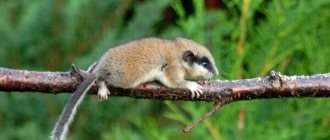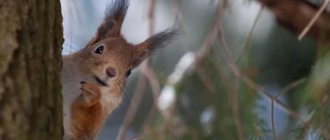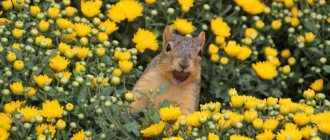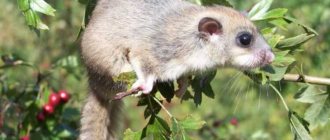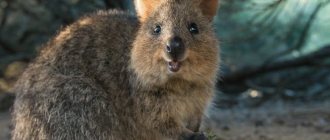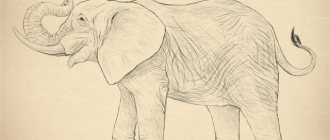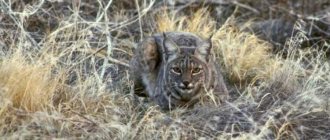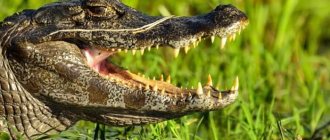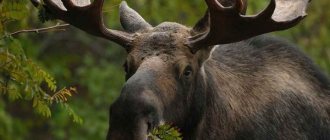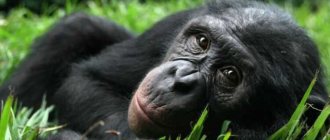Review author: “ZooVita”
At first glance, this mysterious animal from the order of rodents evokes tenderness and keen interest. These furry animals are so small that they fit completely into the palm of an adult. You can recognize a dormouse by its long and fluffy tail, as well as by its specific fur color.
Photos of forest dormouse can be found on the pages of reference books of fauna and wildlife representatives.
Forest dormouse in nature
The modern habitat of the forest dormouse covers a significant territory: Central and Eastern Europe, the Balkan Peninsula, Turkey, the European part of Russia, the Caucasus and the mountainous regions of Central and Central Asia.
This is a typical inhabitant of forests with undergrowth. Prefers to inhabit deciduous forests, bush thickets, abandoned gardens, shelterbelt forests, and tree nurseries. Does not like forests without dense undergrowth and coniferous forests.
The territory in which the animal spends its entire life is very small in area: its radius does not exceed 300 m.
As shelters, it uses both natural shelters (hollows in old trees, crevices of stumps) and nests of its own making.
In summer, this is a loose and loosely woven spherical nest of branches and leaves, often without even an internal soft litter.
After all, the dormouse does not live in such a house for long, only a few days, and then moves to a new home. There can be up to 8 such temporary “apartments” on her property, literally 100 meters from one another.
Note!
Chinchilla at home - description, color, character, features and conditions of detention. All the pros and cons of maintaining a house + reviews
Marmots - life features, interesting facts, habitat, photos, enemies, population
- The gerbil is a representative of rodents, features, habitat, diet, interesting facts + photos
Where there is such an opportunity, the dormouse prefers not to build its own nests, but to occupy artificial nesting sites intended for birds. Or occupy empty nests of large birds, completing and rebuilding them for yourself.
Cancers
The life span of women reaches 73 years, men - 68. Those representatives of the sign who ignore the rules of a healthy lifestyle and do not visit doctors “meet God” early. This is all due to their suspiciousness and fixation on illness rather than recovery. Cancers often suffer from vascular diseases, myopia and gastrointestinal disorders.
Advice: The stars indicate an increased susceptibility to cancer pathologies, so do not forget to take mandatory preventive measures.
Tail or life?
An incredible and surprising property of the tail of all dormouse is autotomy.
If you grab a fleeing dormouse by the tail, the skin will tear and peel off the shaft, like a glove from a hand. The remaining bare twig will dry out and fall off, or over time the dormouse will gnaw it off itself.
Without a tail, it is not so easy to jump and maintain balance, but it is still better than losing your life. Remember this when trying to catch a fleeing animal, and under no circumstances catch it by the tail!
Life expectancy is up to 3 years, with an exception of 4 years.
Twins
The average life expectancy for men is 78 years, for women - 85. Geminis are prone to searching for meaning in their lives and reflecting on its frailty. They are often overcome by boredom and despondency, turning into depression. As a result, problems with the respiratory system, weight and limb diseases may arise.
Advice: Monitor your diet carefully and avoid any debilitating diets. Your body is especially susceptible to exhaustion.
Feeding
The forest dormouse is omnivorous. This is exactly the case when the expression “appearances are deceiving” would be appropriate: a cute fluffy animal is a predator whose diet includes not only food of plant origin.
In nature, this small rodent deftly hunts insects (adults and larvae), destroys nests of birds, and, on occasion, will not refuse a chick or a mouse.
Therefore, the presence of animal food in the diet is a prerequisite. This could be a raw egg, meat, a large cockroach, mealworms, or insect pupae.
Forest dormice, which receive only plant food, lose activity after a week, and females can even eat their cubs.
Any plant food is suitable - it all depends on the individual preferences of the animal.
Fruits (apples, pears, grapes), berries (raspberries, strawberries, strawberries, etc.), nuts (walnuts, pine nuts, peanuts, hazel - pre-chopped), seeds (including melons, pumpkins, watermelons), acorns , fruit seeds. It has been noticed that dormice living in captivity prefer the same seasonal food as their free counterparts.
For example, in the spring, when animals come out of hibernation, what can the forest dormouse eat? Perhaps buds and bark - also a dormouse living in a house and having any food to choose from will prefer buds and bark in the spring.
Among products not available in nature, domestic dormouse happily eat honey, sugar, jam, cookies, white bread soaked in milk, and sweet natural juice.
But no matter how much animals love such products, there should be a minimum amount of them in the diet.
Regardless of the availability of succulent food, there should always be fresh water in the cage. It gets dirty quickly, so you need to change the water daily.
Character and lifestyle
Small rodents are active, do not tolerate loneliness, and love to be among their relatives. They are always active and have difficulty getting along at home. Sonya, as a pet , gets along better when she has a mate, but some species prefer loneliness.
These mammals are very cautious and are frightened by any unexpected sounds. Therefore, a shelter must be provided for a pet, otherwise the rodent may suffer a nervous shock.
The hazel dormouse and dormouse are the fastest to get used to people, but it is necessary to get a cute pet at an early age so that there are fewer problems with adaptation. Then these babies will be eagerly awaiting your arrival to feast on your hands.
These species have a beautiful fur coat. The very thick and soft fur will not leave any adult indifferent, and will completely amaze a small child. Look at this photo, where the animal dormouse looks with its black beady eyes so that you involuntarily want to touch this fluffy ball.
Despite its harmless appearance, it should be noted that dormice can bite quite strongly, even if you have already made friends with it. This happens because they are very shy and any rustle can provoke a defensive reaction.
Dormouse animals also very nimble, so if you pick up an animal in your hands, you may not be able to follow its immediate escape. In a fraction of a second, the sleepyhead will be on your head, and then, perhaps, on the curtain and eventually will be free.
So you need to be on your guard and not give the fugitive the opportunity to disappear from sight. I would like to warn you that you should not grab this animal by the tail, as it can rush forward and you will only have a thin fluffy skin in your hands. The trouble is that after this the tail does not grow back.
And these animals deftly crawl into even the narrowest vertical cracks, and it should be noted that not only in trees, but also in domestic dwellings. This is facilitated by the natural gift of shrinking from the sides.
Under natural conditions, this unique opportunity saves lives. Thanks to its excellent hearing, the dormouse can hide from danger in time. The ears, like locators, constantly rotate independently of each other. The garden dormouse has the largest ears.
Dormouse is a nocturnal animal, but in captivity their lifestyle can be changed. To do this, you need to illuminate the habitat at night, and backlight it with a blue or red lamp during the day.
Watching their acrobatic tricks can give you great pleasure and a great mood for the whole day. Often the dormouse animal can be seen in a pet store, as well as in a specialized nursery, so every lover to buy
Reproduction of forest dormouse
Forest dormice kept in captivity are capable of producing viable offspring. Sexual maturity of young animals occurs after the first winter hibernation, in the second year of life.
The duration of pregnancy is 27-28 days. The number of cubs in a litter is usually 5-7 (from 2 to 9).
Babies are born naked, blind, with closed ear openings and the auricle tightly pressed to the head, with fused toes. The length of the body is about 3 cm, weight no more than 2.5 grams.
Little dormouse grow and develop quickly:
- On the 3rd day the ear comes off
- on the 9th day the fingers separate, the body begins to become covered with hair
- on days 14-18 they begin to see clearly, the lower incisors already exist and the upper ones begin to grow
- at 3 weeks they try solid food
They feed on mother's milk until 4 weeks of age. At one and a half months they can already live independently, but they do not leave the nest voluntarily.
Two-month-old forest dormouses are no different in appearance from adults, although their teeth continue to grow until their first winter hibernation.
Description of the rodent
— Advertising —
Externally, dormice resemble mice or squirrels. Their body length is 8-20 cm. The tail is from 4 to 17 cm long, densely pubescent in most species, only in selevinia and mouse-like dormouse it is half naked. The ears are round in shape, without tufts. The paws are short, with well-developed sharp claws. The fur is thick and soft. The back is colored from gray to ocher-brown.
Security status
The forest dormouse could be classified as a prosperous and quite prosperous species, for whose fate there is no need to worry.
However, in some areas of their range their numbers are steadily declining. The species is already listed in the Red Books of individual regions (Kursk, Lipetsk, Oryol, Tambov regions).
Along with three other species of dormouse, it is included in the list of specially protected animals of the Republic of Tatarstan.
The conservation status of the forest dormouse in the Red Book is designated as causing the least concern. However, how many people have had the pleasure of observing dormouse in nature?
Natural enemies
The main enemy of the forest dormouse is the gray owl . This is an owl with a wingspan of up to one meter. It is medium in size, weighing no more than 600 grams. This bird lives in the same places as the forest dormouse and is active only after sunset.
Return to content
Photo of forest dormouse
Scorpios
Scorpios live a relatively short life - women on average up to 62 years, men up to 63 years. Astrologers explain this by saying that Scorpios are difficult to treat. They prefer to complete their life journey before reaching a ripe old age, just to get rid of any medical intrusion into their lives.
Advice: Life will become longer without doctors if you pay enough attention to the prevention of diseases of the throat and genitourinary system.
Capricorns
Capricorns are very resilient. They bravely endure numerous illnesses that haunt them until old age. Not only do some of them have to endure dozens of illnesses in their lifetime, but they are also susceptible to high rates of injury. The incessant attack on health does not allow Capricorn women to live longer than 80 years, and men - 77.
Advice: In adulthood, there is a high threat to joints, hearing, biliary tract and digestive system.
Little poison dart frog
The forest dormouse boasts the beauty of its tail. In addition, it acts as a kind of rudder, which helps to stay level in the trees. Thanks to it, you can easily determine the mood of the animal.
An angry or frightened animal makes its tail fluffy, as seen in the photo of a forest dormouse. So she seems much larger than her true size. When completely calm, the tail looks smooth.
The forest dormouse loves active tree climbing. She is able to climb even the thinnest branch. This helps her with narrow and elongated feet. She uses her fingers to cling to tree branches.
Antennae, otherwise called vibrissae, grow on the dormouse's face. Thanks to this organ, the animal can easily feel the place near itself.
Vibrissae make up approximately 20% of the total size of the dormouse's body. The hairs have some mobility due to a group of muscles located under the skin.
Sagittarius
The poor health of Sagittarius also affects their life expectancy. The musculoskeletal and cardiovascular systems with a full bouquet of chronic diseases literally shorten Sagittarius’ lives. Women rarely cross the 73-year-old threshold, and men - 69-year-old.
Advice: Sagittarius women should pay special attention to hair, nails and skin, Sagittarius men - to the prostate.
